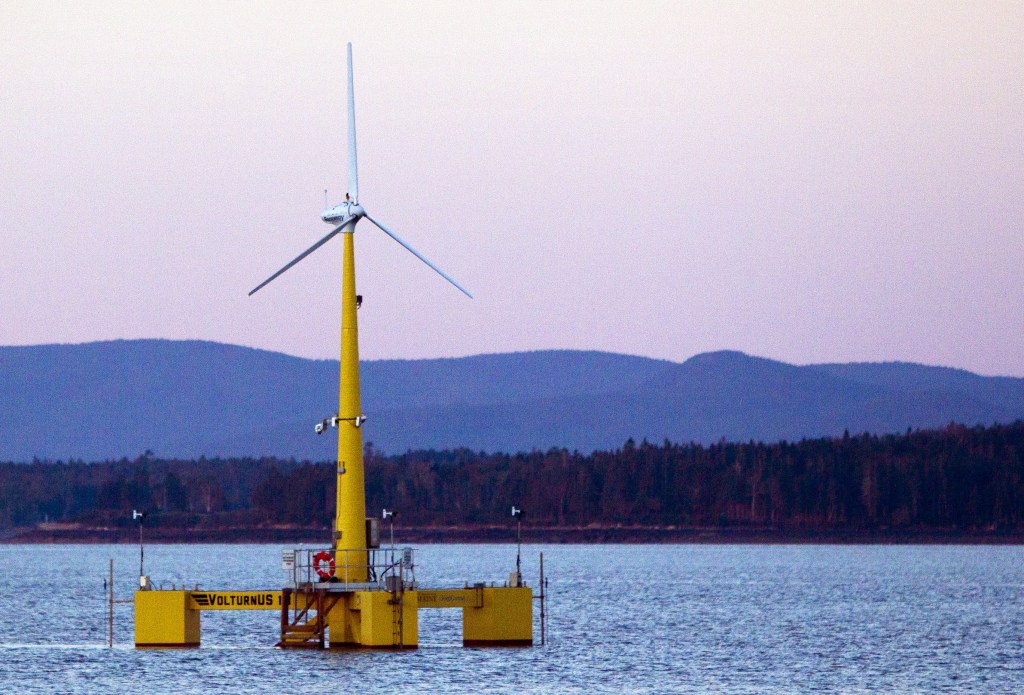AUGUSTA — The University of Maine and its partner companies have offered a glimpse into their offshore wind project proposal, releasing information about plans to supply some power directly to Monhegan Island, the companies working on the project and more specifics on its technology.
A redacted proposal for the Maine Aqua Ventus project was released Wednesday. The plan to build two wind turbines — generating 12 megawatts of power 2 1/2 miles south of Monhegan Island and about 12 miles from the mainland — is the sole offshore project being considered for a state contract following Norwegian company Statoil’s departure last month.
Some details about the Maine Aqua Ventus project have already been made public, including hopes to eventually build one or more large commercial offshore wind farms in federal waters, producing up to 500 megawatts of power.
Others, including critical information about what the project would cost ratepayers, the project’s total cost and the projected economic impacts on the state, like the number of jobs expected to be created, will remain confidential until later this month.
Jake Ward, vice president of Innovation and Economic Development for UMaine, said the proposal highlights the university and its partner companies’ strong overall approach that they believe gives them a good shot at winning a $46 million federal energy grant later this year.
“We put a solid team together with expertise both within the state and internationally, both who understand this environment and how to do these types of projects,” he said.
Environmental groups and lawmakers called for a release of a redacted version of the proposal after it was submitted in August. They said that the unusual circumstances of the reopening of the bid process in July — after Statoil had already obtained a tentative agreement with the state — called for full transparency.
The project builds upon technology behind a wind turbine the university launched off the coast near Castine in June called VolturnUS, a 65-foot-tall prototype that’s one-eighth the size of a full-scale turbine.
The university hopes to provide 300 kilowatts of power directly to Monhegan Island where residents currently have extremely high energy costs due to their reliance on diesel generators for power, said Jeff Thaler, assistant counsel to the university. The Maine Aqua Ventus project will attempt to eventually provide free electricity to the island, the proposal says.
While designed to generate 12 megawatts of power, the project will have a capacity of up to 25 megawatts, allowing additional test turbines to be connected in the future. That means turbine manufacturers and other designers will be able to test their designs starting in 2015, spurring “further domestic innovation and offshore wind cost-reduction,” according to the proposal.
The university had objected to the calls for the project’s release, saying the proposal was crafted with the promise of it remaining private and that releasing information would harm its chances for the grant that five other proposed projects — in Virginia, Texas, New Jersey, Ohio and Oregon — are also pursuing.
Statoil announced last month that it was abandoning its $120 million project in Maine and focusing its efforts in Scotland.
Sean Mahoney, executive vice president of the Conservation Law Foundation, one of the groups that formally requested that the university release the proposal, said Wednesday that without information about the cost, how the project is going to be financed and the economic impact, it remains impossible to tell whether the Maine Aqua Ventus project will be viable and make up for the loss of Statoil’s project.
“We hope that when we get more information that we’re going to be able to say that this is as good, if not a better project than the Statoil one was,” he said. “But we remain concerned that at the end of the day, we could be looking at a situation where we don’t have any projects in the Gulf of Maine and that is tragic.”
Send questions/comments to the editors.



Success. Please wait for the page to reload. If the page does not reload within 5 seconds, please refresh the page.
Enter your email and password to access comments.
Hi, to comment on stories you must . This profile is in addition to your subscription and website login.
Already have a commenting profile? .
Invalid username/password.
Please check your email to confirm and complete your registration.
Only subscribers are eligible to post comments. Please subscribe or login first for digital access. Here’s why.
Use the form below to reset your password. When you've submitted your account email, we will send an email with a reset code.